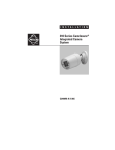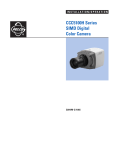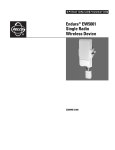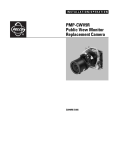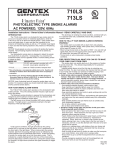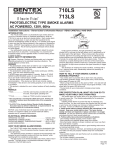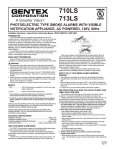Download Pelco IS310-CW User's Manual
Transcript
I N S T A L L A T I O N IS310 Series Camclosure® Integrated Camera System C3429M-A (1/08) Important Safety Instructions 1. Read these instructions. 2. Keep these instructions. 3. Heed all warnings. 4. Follow all instructions. 5. Do not block any ventilation openings. Install in accordance with the manufacturer’s instructions. 6. Do not install near any heat sources such as radiators, heat registers, stoves, or other apparatus (including amplifiers) that produce heat. 7. Only use attachments/accessories specified by the manufacturer. 8. Use only with the cart, stand, tripod, bracket, or table specified by the manufacturer, or sold with the apparatus. When a cart is used, use caution when moving the cart/apparatus combination to avoid injury from tip-over. 9. Refer all servicing to qualified service personnel. Servicing is required when the apparatus has been damaged in any way, such as power-supply cord or plug is damaged, liquid has been spilled or objects have fallen into the apparatus, the apparatus has been exposed to rain or moisture, does not operate normally, or has been dropped. 10. Installation should be done only by qualified personnel and conform to all local codes. 11. Unless the unit is specifically marked as a NEMA Type 3, 3R, 3S, 4, 4X, 6, or 6P enclosure, it is designed for indoor use only and it must not be installed where exposed to rain and moisture. 12. Use only installation methods and materials capable of supporting four times the maximum specified load. 13. Use stainless steel hardware to fasten the mount to outdoor surfaces. 14. To prevent damage from water leakage when installing a mount outdoors on a roof or wall, apply sealant around the bolt holes between the mount and mounting surface. 15. CAUTION: These servicing instructions are for use by qualified service personnel only. To reduce the risk of electric shock do not perform any servicing other that contained in the operating instructions unless you are qualified to do so. 16. Only use replacement parts recommended by Pelco. The product and/or manual may bear the following marks: This symbol indicates that dangerous voltage constituting a risk of electric shock is present within this unit. This symbol indicates that there are important operating and maintenance instructions in the literature accompanying this unit. 2 CAUTION: RISK OF ELECTRIC SHOCK. DO NOT OPEN. C3429M-A (1/08) Regulatory Notices This device complies with Part 15 of the FCC Rules. Operation is subject to the following two conditions: (1) this device may not cause harmful interference, and (2) this device must accept any interference received, including interference that may cause undesired operation. RADIO AND TELEVISION INTERFERENCE This equipment has been tested and found to comply with the limits of a Class B digital device, pursuant to Part 15 of the FCC Rules. These limits are designed to provide reasonable protection against harmful interference in a residential installation. This equipment generates, uses, and can radiate radio frequency energy and, if not installed and used in accordance with the instructions, may cause harmful interference to radio communications. However there is no guarantee that the interference will not occur in a particular installation. If this equipment does cause harmful interference to radio or television reception, which can be determined by turning the equipment off and on, the user is encouraged to try to correct the interference by one or more of the following measures: • Reorient or relocate the receiving antenna. • Increase the separation between the equipment and the receiver. • Connect the equipment into an outlet on a circuit different from that to which the receiver is connected. • Consult the dealer or an experienced radio/TV technician for help. You may also find helpful the following booklet, prepared by the FCC: “How to Identify and Resolve Radio-TV Interference Problems.” This booklet is available from the U.S. Government Printing Office, Washington D.C. 20402. Changes and Modifications not expressly approved by the manufacturer or registrant of this equipment can void your authority to operate this equipment under Federal Communications Commission’s rules. This Class B digital apparatus complies with Canadian ICES-003. Cet appareil numérique de la classe B est conforme à la norme NMB-003 du Canada. The materials used in the manufacture of this document and its components are compliant to the requirements of Directive 2002/95/EC. This equipment contains electrical or electronic components that must be recycled properly to comply with Directive 2002/96/EC of the European Union regarding the disposal of waste electrical and electronic equipment (WEEE). Contact your local dealer for procedures for recycling this equipment. C3429M-A (1/08) 3 Description The 310 Series Camclosure® integrated camera system is a track-light design that mounts to a wall or ceiling. The system incorporates a camera and lens package into a small, unobstructive, medium-security enclosure designed for areas subject to vandalism. The system is quick and easy to install in a variety of indoor or outdoor applications. It is ideal for residential, office, mall, hospital, school, parking garage, correction and detention, and other medium-security installations subject to vandalism. PARTS LIST The following parts are supplied: Qty Description 1 Camclosure integrated camera system 1 Hollow screwdriver bit (1/8-inch) 4 C3429M-A (1/08) Installation PREPARE WALL OR CEILING Prepare the wall or ceiling according to one of the following options. • Mounting directly to wall or ceiling WALL OR CEILING Figure 1. Wall/Ceiling Mounting • Mounting to a 4S electrical box with 404 plaster ring 4S ELECTRICAL BOX WALL OR CEILING 404 PLASTER RING ICS310-AP ADAPTER PLATE (NOT SUPPLIED) 6-32 X 0.50 SECURITY SCREW (SUPPLIED WITH ADAPTER PLATE) Figure 2. Mounting to a 4S Electrical Box • Mounting to ICS310-COND conduit adapter (not supplied) WALL OR CEILING CONDUIT ADAPTER Figure 3. Conduit Mounting C3429M-A (1/08) 5 • Mounting to a 2-gang electrical box 2-GANG ELECTRICAL BOX WALL OR CEILING ICS310-AP ADAPTER PLATE (NOT SUPPLIED) 6-32 X 0.50 SECURITY SCREW (SUPPLIED WITH ADAPTER PLATE) Figure 4. Mounting to a 2-Gang Electrical Box CONNECT VIDEO AND POWER 1. Some indoor installations do not require a heater. If the installation does not require a heater, disconnect the heater wiring. a. Remove the cover with the supplied 1/8-inch hollow screwdriver bit. b. Remove the camera from the mounting bracket, and unplug the 4-pin heater connector in the base. c. Reinstall the camera. If the camera has a varifocal lens, leave the cover off; it will be reinstalled later. Otherwise, reinstall the cover. 2. Connect the power input wires to the power wires of the IS310 base (refer to Table A). Table A. Power Input Voltage Red Wire Black Wire 12 VDC + Ground 24 VAC ~ ~ 3. Connect the video cable/wires: • • 6 BNC: Connect the BNC connector from the unit to a mating BNC connector. UTP: Connect the blue wire to Video +; connect the gray wire to Video -. C3429M-A (1/08) BASE VENT COVER PHILLIPS PAN HEAD SCREW LOCK WASHER CAMERA MODULE TAMPER-RESISTANT SCREWS Figure 5. Exploded Parts View WARNING: To prevent damage to the camera or lens, the camera must be installed in the proper hole of the mounting bracket (refer to Figure 6). If the camera is not installed in the correct hole, the window of the enclosure may be forced against the lens. MOUNT CAMERA HERE DO NOT USE Figure 6. Camera Mounting Holes ATTACH BASE 1. Release the base locking ring for access to the mounting holes. 2. Attach the base to an adapter plate or conduit adapter using the two 6-32 x 1.25-inch tamper-resistant screws supplied with the adapters. Use the 1/8-inch hollow screwdriver bit supplied with the Camclosure. Mounting hardware for all other applications is not supplied. C3429M-A (1/08) 7 ADJUST ENCLOSURE 1. Turn on power to the camera and monitor. 2. Release one or both locking rings, and swivel the enclosure until the angle of the camera is correct (refer to Figure 7). 3. Tighten the locking rings. LOCKING RINGS Figure 7. Adjusting Enclosure Position 4. If you have a varifocal lens, remove the cover with the supplied 1/8-inch hollow screwdriver bit. WARNING: Heater elements could be hot! When camera power is on, use caution when adjusting the camera. This applies to all models. 5. Loosen the focal length and focus locking screws (refer to Figure 8), and then adjust the lens according to the scene detail. VARIFOCAL LENS LOCKING SCREWS Figure 8. Varifocal Locking Screws 6. Retighten the screws. 7. Reseat the O-ring on the cover and reinstall the cover. 8 C3429M-A (1/08) DN/CH SERIES ADJUSTMENTS Refer to Figure 9 to adjust the IS310-DN or IS310-CH model. Figure 9. Adjusting the IS310-DN/CH Series Camclosure SWITCH SETTINGS Locate the DIP switch. Then set the switches for your installation. SW4-1: Auto Gain Control The automatic gain control (AGC) adjusts the image automatically to compensate for changes in light levels. Set SW4-1 to ON to enable AGC. Set it to OFF to disable AGC. The default setting is ON. SW4-2: Backlight Compensation The backlight compensation (BLC) feature compensates for backlit scenes by enhancing objects in the center of the scene. Set SW4-2 to ON to enable BLC. Use this setting if a bright backlight is present and the subject in the center of the picture appears dark or as a silhouette. Set it to OFF to disable backlight compensation. This is the default setting. SW4-3: Line Sync When multiple cameras are connected to the same switching device, vertical roll may occur on the monitor. AC line lock eliminates vertical roll by locking the frame rate to the power supply frequency. Each camera output is synchronized to the power supply frequency. Refer to Vertical Phase Adjustment on page 10 for more information. Internal line sync disables the line lock and synchronizes cameras internally. Set SW4-3 to OFF to use AC line lock. Set it to ON to use internal line sync. The default setting is OFF. SW4-4: Flickerless In certain lighting conditions, a flicker in the light source may affect camera operation. Flickering can be caused by a number of conditions, including the quality of the source power and the age and type of fluorescent bulbs and ballasts. C3429M-A (1/08) 9 Set to SW4-4 ON to enable flickerless operation. The camera will remove the effects of flickering and the shutter speed will be set to 1/120 (NTSC) or 1/100 (PAL). Set to SW4-4 OFF to disable flickerless operation. This is the default setting. NOTE: If you enable flickerless operation, you should use AC line lock for best results. SW4-5: Auto White Balance/Manual White Balance Auto white balance (AWB) is enabled by default (OFF). To manually set and lock the white balance: 1. Set SW4-5 to OFF. 2. Hold a white background in front of the lens until the video is all white. 3. While holding the background in place, set SW4-5 to ON. A blue blinking block appears on the video image for a few seconds. When the block changes to solid green, the manual white balance (MWB) process is complete. SW4-6: Reserved Do not change SW4-6 from its factory setting. SW4-6 must be set to OFF for varifocal models; it must be set to ON for fixed iris lenses. AUTO IRIS LEVEL ADJUSTMENT To adjust the auto iris DC drive level (refer to Figure 9 on page 9): 1. Tilt or rotate the camera module until you can access the auto iris level control (R19). 2. Turn the screw clockwise to increase the brightness level or counterclockwise to decrease the brightness level. VERTICAL PHASE ADJUSTMENT NOTES: • Use this procedure for 24 VAC operation only. • When adjusting vertical phase, line sync (SW4-3) must be set to OFF for AC line lock. When using more than one camera power supply, a brief vertical roll may occur on the monitor when switching from one camera to another. To eliminate vertical roll, reverse the 24 VAC connections on one camera. If both cameras are connected to the same transformer, this should solve the problem. If the problem continues, adjust the phase control by synchronizing, or line locking, the cameras to one another. 10 C3429M-A (1/08) Adjusting Vertical Phase You may need two people when synchronizing the cameras: one at the camera, the other at the monitor to observe the vertical roll and the effect of any camera adjustments. To synchronize the cameras: 1. Choose a reference camera to which all other cameras will be phased. 2. Select the camera to synchronize. Use buttons SW1 and SW2 to synchronize the camera to the reference camera (refer to Figure 9 on page 9). SW1 increases vertical phase; SW2 decreases vertical phase. 3. Each time an adjustment is made, switch back and forth between the camera you are adjusting and the reference camera. Repeat this process as many times as necessary until the roll between the cameras is no longer noticeable. 4. Adjust the phase of all other cameras by repeating steps 2 and 3. Always adjust to the reference camera selected in step 1. NOTE: The preferred method for camera phase adjustment is to use a dual trace oscilloscope to align the vertical sync pulses of the reference camera to the selected camera(s). BLEMISH DETECTION If small white or colored spots appear in the video image, one or more pixels on the camera imager may be defective. (This condition is common for both CCD and CMOS imagers.) DN and CH series cameras with auto iris lenses automatically detect and correct defective pixels during startup. Video turns on, then off, and then on again. If white or colored spots still appear, you can correct the defective pixels manually. CH Series cameras with fixed iris lenses do not automatically detect and correct defective pixels. You can correct the defective pixels manually. To manually correct defective pixels (refer to Figure 9 on page 9): 1. Cover the lens completely. Make sure no light can enter the lens. NOTE: The mechanical iris lens aperture does not completely block the light. 2. Press and hold button SW3 for one second. The camera will find and correct defective pixels. NOTE: Any defective pixels that cannot be completely corrected may still appear. 3. Release button SW3. 4. Uncover the lens for normal camera operation. C3429M-A (1/08) 11 DAY/NIGHT OPERATION NOTE: This section only applies to DN model cameras. DN model cameras regularly check the brightness level of the field of view to determine when to switch between day (color) and night (black-white) operation. Actual brightness threshold levels are affected by camera angle, amount of zoom, field of view, lens, and type of lighting. The switching process lasts from 7-10 seconds. RISING LIGHT LEVEL COLOR MODE 1.5 lux B-W MODE COLOR MODE 3.0 lux B-W MODE FALLING LIGHT LEVEL Figure 10 and Table B on page 12 show how the camera switches between color and black-white operation. Figure 10. DN Models Threshold Switching Levels Table B. DN Models Switching Thresholds Color to B-W 1.5 lux ±1.0 lux B-W to Color 3.0 lux ±1.0 lux NOTE: These switching thresholds are approximate. Use the thresholds in Table A as a guide when installing the unit. 12 C3429M-A (1/08) DW/CW SERIES (WIDE DYNAMIC RANGE) ADJUSTMENTS Refer to Figure 11 to adjust the IS310-DW or IS310-CW model. SW1 DEFAULT SWITCH POSITION R7 Figure 11. Adjusting the IS310-DW/CW Series Camclosure SWITCH SETTINGS Locate the DIP switch and then set the switches for your installation. SW1-1: Video Format Set SW1-1 to ON for NTSC. Set it to OFF for PAL. The default setting is ON. SW1-2: Line Sync When multiple cameras are connected to the same switching device, vertical roll may occur on the monitor. AC line lock eliminates vertical roll by locking the frame rate to the power supply frequency. Each camera output is synchronized to the power supply frequency. Refer to Vertical Phase Adjustment on page 16 for more information. Internal line sync disables line lock and synchronizes cameras internally. Set SW-1 to ON to use AC line lock. Set it to OFF for internal line sync. The default setting is ON. SW1-3: Interlaced Scanning/Progressive Scanning Interlaced scanning is the standard for analog recording installations. Each frame contains one odd and one even field, and each are processed separately. Progressive scanning is better for digital recording installations. Each frame is processed as a whole, which results in less blurring and cleaner digital conversion. It also saves storage space on digital video recorders. Set SW1-3 to ON to select interlaced scanning. Set it to OFF to select progressive scanning. The default setting is ON. C3429M-A (1/08) 13 SW1-4: Auto White Balance/Manual White Balance Auto white balance (AWB) is enabled by default (ON). To manually set and lock the white balance: 1. Set SW1-4 to ON. 2. Hold a white background in front of the lens until the video is all white. 3. While holding the background in place, set SW1-4 to OFF. A green block and a white block alternate briefly on the video image until the manual white balance (MWB) process is complete. SW1-5: Fluorescent/General Enable this option to adjust the camera for best operation under fluorescent lighting. Set SW1-5 to OFF for fluorescent lighting. Set it to ON for general lighting. The default setting is ON. NOTE: If you use fluorescent operation, you should use AC line lock for best results. SW1-6: General Maximum Wide Dynamic Range Maximum wide dynamic range (WDR) supports about 36 dB of additional dynamic range over a standard camera. Use it for installations that require the maximum WDR. General WDR supports about 20 dB of additional dynamic range over a standard camera. Use it for installations that do not require the maximum WDR. Set SW1-6 to ON to select maximum WDR. Set it to OFF to select general WDR. The default setting is ON. SW1-7: Digital Slow Shutter The default shutter speed for NTSC is 30 frames per second (fps); 25 fps for PAL. This is also known as SENS 2X. You can decrease the shutter speed to 7.5 fps (NTSC) or 6.25 fps (PAL). This is known as SENS 8X, which improves low light sensitivity. Set SW1-7 to ON to select SENS 2X. Set it to OFF to select SENS 8X. The default setting is ON. 14 C3429M-A (1/08) SW1-8: Day/Night Operation (DW models only) NOTE: On CW models, SW1-8 is unused and does not affect camera operation. DW model cameras regularly check the brightness level of the field of view to determine when to switch between day (color) and night (black-white) operation. Use SW1-8 to set the general light levels at which the camera will automatically switch. Set SW1-8 to ON (dark) to use standard thresholds to switch between color and black-white operation. This is the default setting. Set SW1-8 to OFF (dusk) to use higher light thresholds to switch between color and black-white operation. Actual brightness threshold levels are affected by camera angle, amount of zoom, field of view, lens, and type of lighting. The switching process lasts from 7-10 seconds. B-W MODE B-W MODE 4.0 lux DARK RISING LIGHT LEVEL COLOR MODE FALLING LIGHT LEVEL 7.0 lux B-W MODE 1.0 lux B-W MODE 3.0 lux RISING LIGHT LEVEL COLOR MODE COLOR MODE FALLING LIGHT LEVEL COLOR MODE Figure 12 and Table C show how the camera switches between color and black-white operation for each setting. DUSK Figure 12. DW Models Threshold Switching Levels Table C. DW Models Switching Thresholds Dark (ON) Dusk (OFF) Color to B-W 1.0 lux 4.0 lux B-W to Color 3.0 lux 7.0 lux NOTE: These switching thresholds are approximate and were measured using a 3.0 mm to 9.5 mm lens at f/1.0. Use the thresholds in Table C as a guide when installing the unit. C3429M-A (1/08) 15 AUTO IRIS LEVEL ADJUSTMENT The electronics of the IS310-DW and IS310-CW Series Camclosures automatically adjust the camera to the auto iris. Auto iris level adjustments are not necessary. VERTICAL PHASE ADJUSTMENT NOTES: • Use this procedure for 24 VAC operation only. • When adjusting vertical phase, line sync (SW1-2) must be set to ON for AC line lock. When using more than one camera power supply, a brief vertical roll may occur on the monitor when switching from one camera to another. To eliminate vertical roll, reverse the 24 VAC connections on one camera. If both cameras are connected to the same transformer, this should solve the problem. If the problem continues, adjust the phase control by synchronizing, or line locking, the cameras to one another. Adjusting Vertical Phase You may need two people when synchronizing the cameras: one at the camera, the other at the monitor to observe the vertical roll and the effect of any camera adjustments. To synchronize the cameras: 1. Choose a reference camera to which all other cameras will be phased. 2. Select the camera to synchronize. Use the phase adjustment control (R7) to synchronize the camera to the reference camera (refer to Figure 11 on page 13). Turn R7 clockwise to increase vertical phase; turn R7 counterclockwise to decrease vertical phase. 3. Each time an adjustment is made, switch back and forth between the camera you are adjusting and the reference camera. Repeat this process as many times as necessary until the roll between the cameras is no longer noticeable. 4. Adjust the phase of all other cameras by repeating steps 2 and 3. Always adjust to the reference camera selected in step 1. NOTE: The preferred method for camera phase adjustment is to use a dual trace oscilloscope to align the vertical sync pulses of the reference camera to the selected camera(s). BLEMISH DETECTION If small white or colored spots appear in the video image, one or more pixels on the camera imager may be defective. (This condition is common for both CCD and CMOS imagers.) DW and CW Series cameras have auto iris lenses and automatically detect and correct defective pixels during startup. Manual pixel correction is not available. 16 C3429M-A (1/08) Service Connector The IS310 Series Camclosure integrated camera system includes a service connector that outputs camera video. Use it at the installation site to set up the field of view and focus the camera. SERVICE CONNECTOR Figure 13. Service Connector Pelco offers two optional items that plug directly into the service connector: CST150 compact field tool and IS-SC cable. • The optional CST150 compact field tool has a 3-foot (0.9 m) cable and microdisplay for viewing camera video. Plug it into the service connector to view the video. NOTE: The three buttons on the CST150 are not used with the IS310 Series Camclosure. • The optional IS-SC is a 4-foot (1.2 m) cable with a service connector and a BNC connector. Plug the cable into the service connector on the IS310. Then connect the other end to any standard BNC (VIDEO IN) connector on a monitor. To assemble a longer service cable for the Camclosure integrated camera system, purchase the following items from a local electronics supply store: Qty 1 1 1 Description 2.5 mm monaural headphone plug CPM 88 miniature coaxial connector RG174/U coaxial cable To assemble the cable: 1. Attach the CPM 88 miniature coaxial connector to one end of the cable. Follow the directions supplied with the miniature coaxial connector. 2. Attach the 2.5 mm monaural plug to the other end of the coaxial cable (refer to Figure 14): a. Remove the support sleeve from the plug. Slip the support sleeve over the end of the cable. b. Prepare the cable. Solder the center connector of the cable to the center pin of the plug. Thread the braid of the cable through the hole in the crimp pin. c. Solder the braid to the top of the crimp pin. Crimp the end of the crimp pin around the cable. Reassemble the support sleeve and the plug. CENTER CONDUCTOR COAXIAL CABLE BRAID (SHIELD) 2.5 MM MONAURAL HEADPHONE PLUG Figure 14. Attaching the 2.5 mm Monaural Headphone Plug C3429M-A (1/08) 17 Specifications General Pan/Tilt Adjustment Pan Tilt Construction Finish Environment Operating Temperature Heater Unit Weight Electrical Input Voltage Power Consumption Video Connector Manual 180° 180° Aluminum base and cover, steel camera mounting bracket Gray polyester powder coat Low temperature, indoor/outdoor -50° to 122°F (-46° to 50°C); de-ices to -10°F (-23°C) Turns on at 50°F (10°C) and off at 80°F (27°C) 1.45 lb (6 kg) 12 VDC or 24 VAC, ±10% 13 W or less BNC UTP wires 4.26 (10.82) 7.14 (18.14) 2.87 (7.29) 2.01 (5.10) 3.50 (8.89) 1.31 (3.32) 2.76 (7.01) NOTE: VALUES IN PARENTHESES ARE CENTIMETERS; ALL OTHERS ARE INCHES. (Design and product specifications subject to change without notice.) 18 C3429M-A (1/08) PRODUCT WARRANTY AND RETURN INFORMATION WARRANTY Pelco will repair or replace, without charge, any merchandise proved defective in material or workmanship for a period of one year after the date of shipment. Exceptions to this warranty are as noted below: • • • • • • • • • • • • • • Five years on fiber optic products and TW3000 Series unshielded twisted pair (UTP) transmission products. Three years on Spectra® IV products. Three years on Genex® Series products (multiplexers, server, and keyboard). Three years on DX Series digital video recorders, DVR5100 Series digital video recorders, DigitalSENTRY® Series hardware products, DVX Series digital video recorders, NVR300 Series network video recorders, and Endura® Series distributed network-based video products. Three years on Camclosure® and Pelco-branded fixed camera models, except the CC3701H-2, CC3701H-2X, CC3751H-2, CC3651H-2X, MC3651H-2, and MC3651H-2X camera models, which have a five-year warranty. Three years on PMCL200/300/400 Series LCD monitors. Two years on standard motorized or fixed focal length lenses. Two years on Legacy®, CM6700/CM6800/CM9700 Series matrix, and DF5/DF8 Series fixed dome products. Two years on Spectra III™, Spectra Mini, Esprit®, ExSite®, and PS20 scanners, including when used in continuous motion applications. Two years on Esprit and WW5700 Series window wiper (excluding wiper blades). Two years (except lamp and color wheel) on Digital Light Processing (DLP®) displays. The lamp and color wheel will be covered for a period of 90 days. The air filter is not covered under warranty. Two years on Intelli-M® eIDC controllers. One year (except video heads) on video cassette recorders (VCRs). Video heads will be covered for a period of six months. Six months on all pan and tilts, scanners, or preset lenses used in continuous motion applications (preset scan, tour, and auto scan modes). Pelco will warrant all replacement parts and repairs for 90 days from the date of Pelco shipment. All goods requiring warranty repair shall be sent freight prepaid to a Pelco designated location. Repairs made necessary by reason of misuse, alteration, normal wear, or accident are not covered under this warranty. Pelco assumes no risk and shall be subject to no liability for damages or loss resulting from the specific use or application made of the Products. Pelco’s liability for any claim, whether based on breach of contract, negligence, infringement of any rights of any party or product liability, relating to the Products shall not exceed the price paid by the Dealer to Pelco for such Products. In no event will Pelco be liable for any special, incidental, or consequential damages (including loss of use, loss of profit, and claims of third parties) however caused, whether by the negligence of Pelco or otherwise. The above warranty provides the Dealer with specific legal rights. The Dealer may also have additional rights, which are subject to variation from state to state. If a warranty repair is required, the Dealer must contact Pelco at (800) 289-9100 or (559) 292-1981 to obtain a Repair Authorization number (RA), and provide the following information: 1. Model and serial number 2. Date of shipment, P.O. number, sales order number, or Pelco invoice number 3. Details of the defect or problem If there is a dispute regarding the warranty of a product that does not fall under the warranty conditions stated above, please include a written explanation with the product when returned. Method of return shipment shall be the same or equal to the method by which the item was received by Pelco. RETURNS To expedite parts returned for repair or credit, please call Pelco at (800) 289-9100 or (559) 292-1981 to obtain an authorization number (CA number if returned for credit, and RA number if returned for repair) and designated return location. All merchandise returned for credit may be subject to a 20 percent restocking and refurbishing charge. Goods returned for repair or credit should be clearly identified with the assigned CA or RA number and freight should be prepaid. REVISION HISTORY Manual # C3429M C3429M-A Date 12/07 1/08 Comments Original version. Revised parts list and Figure 5. Pelco, the Pelco logo, Camclosure, DigitalSENTRY, Endura, Esprit, ExSite, Genex, Intelli-M, Legacy, and Spectra are registered trademarks of Pelco, Inc. Spectra III is a trademark of Pelco, Inc. ©Copyright 2008, Pelco, Inc. DLP is a registered trademark of Texas Instruments Incorporated. All rights reserved. Worldwide Headquarters 3500 Pelco Way Clovis, California 93612 USA USA & Canada Tel: 800/289-9100 Fax: 800/289-9150 International Tel: 1-559/292-1981 Fax: 1-559/348-1120 www.pelco.com ISO9001 Australia | Canada | Finland | France | Germany | Italy | Macau | The Netherlands | Russia | Singapore | Spain | Sweden | United Arab Emirates | United Kingdom | United States South Africa




















